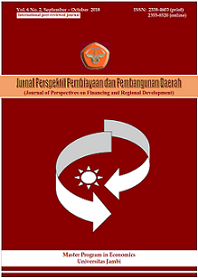Impact of small business management on optimizing business performance (Study on small-scale cake businesses in Sarolangun District)
DOI:
https://doi.org/10.22437/ppd.v6i2.5562Abstract
The purpose of this research is to analyze the corporate governance of Small and Medium-sized Enterprises (SMEs) in Creative Industry from the aspect of industrial profile, financial management, human resources management, operational management and marketing management in Sarolangun District. The population in this study was a group of Small and Medium Industries in Sarolangun District. This study examined 100 companies belonging to the SMEs. Primary data collection is carried out using questioner instrument and Focus Group Discussion techniques by involving stakeholders including business actors, government, academics and consumers. Descriptive analysis approach and statistical analysis/verification also used in this study. SWOT analysis is used for quantitative approach on the other hand matrix were used for qualitative approaches. The weighting and categorization of the results of the research variables suggests that financial management is in good category, marketing management is in good category, human resource management is in good category, operational management is not in good category and lastly business performance is in good category. The results of the SWOT diagram prove that the management position of the small-scale cake maker in Sarolangun District is currently in quadrant I, meaning that small-scale cake-making businesses in Sarolangun District already have the power and opportunity to improve business performance, thus the right strategy to improve the current business performance is through aggressive strategy.
Downloads
References
Arikunto, S. (2010) Prosedur penelitian suatu pendekatan praktik. Jakarta: Rineka Cipta
Crowther, D., Seifi, S. (2010). Corporate Governance and Risk Management.Ventus Publishing ApS.
Dahmiri (2013), Upaya peningkatan daya saing Usaha Kecil dan Menengah di Kabupaten Sarolangun. Sarolangun Jambi.
Instruksi Presiden Republik Indonesia. Nomor 10 Tahun 1999. Tentang. Pemberdayaan Usaha Menengah.
Jogiyanto, 2010, Sistem Informasi Strategik untuk Keunggulan Kompetitif, Penerbit Andi Offset, Yogyakarta
Lumpkin, D.T, Dess, GG (1996), "Clarifying the entrepreneurial orientation construct and iinking it to performance", Academy of Management Revzew, Vol. 21, pp. 135-72.
Mulbert, P. O. (2010). Corporate Governance of Banks after the Financial Crisis- Theory, Evidence, Reforms. ECGI Law Working Paper.
Muzaffar, Ahmed T, (2009), entrepreneurs of the street, an analytical work on the street food vendor of dhaka city, International Journal Of Business management, vol.4 No.2.
Murphy, B.G., Trailer, W.J., and Hill, C.R., 1996. Measuring Performance in Organizational Level Analysis. Journal of Business Reserch, Vol. 36, 15-23.
Munizu, M. (2010). Pengaruh Penerapan Praktik Total Quality of Management (TQM) Terhadap Kinerja Kualitas (Studi Persepsi Karyawan pada PT. Sermani Steel Makassar). Skripsi. Fakultas Ekonomi Universitas Hasanuddin.
Octavia. A. et.al (2012), Evaluasi Usaha Mikro Kecil dan Menengah Penerima Bantuan Pemerintah dan Strategi Peningkatan Daya Saing Usaha Bersangkutan Dalam Rangka Mendorong Perekonomian Provinsi Jambi.
Prawiranegara AS, 1998, Kebijaksanaan Pembinaan Pengusaha Kecil Khususnya Tentang Organisasi Usaha di Indonesiaâ€, dalam Jurna l Ilmu-Ilmu Sosial,
Pengusaha Kecil : Penting dan Kompleksitas Masalahnya, Jakarta : PAU-IS-UI, November 1994.
Rangkuti, F, 2006, †Analisis SWOT Teknik Membedah Kasus Bisnis,PT. Gramedia Pustaka Utama, Jakarta.
Singarimbun, Peter H dan Chris M. 2008. “Penentuan Variabel dan Hubungan Antar Variabelâ€. in Singarimbun, Masri dan Sofian Effendi (ed.). Metode Penelitian Survei. Edisi Revisi. Cetakan ke-19. Jakarta: Pustaka LP3ES (hal. 122-146).
Sutrisno, H, 1992, Statistik 2, Yogyakarta, Penerbit Andi, Yogyakarta
Sucherly (2003), Peranan Manajemen Pemasaran Stratejik dalam Menciptakan Keunggulan Posisional serta Implikasinya terhadap Kinerja Organisasi Bisnis dan Non Bisnis (Pendekatan 5-A). Orasi Ilmiah. Universitas Padjajaran, Bandung.
Supranto, J. 1994. Statistik: Teori dan Aplikasi Jilid 2 (cetakan 5). Jakarta: Erlangga
Stapledon, G.P. (1997). Institutional Share holders and Corporate Governance. Otago Law Review, Vol.9, No.1, pp. 177-179.
Tambunan, M (2004). Melangkah ke depan UKM dalam Perekonomian Indonesia di masa depan, Makalah pada Debat Ekonomi ESEI, 2004, Jakarta Convention Centre, 15-16 September 2004.
Undang-Undang Nomor 20 Tahun 2008 Tentang Usaha Mikro Kecil dan Menengah, Depkumdang dan HAM, Jakarta
Undang Undang No. 9 Tahun 1995. Tentang: Usaha Kecil. Oleh. : Presiden Republik Indonesia. Nomor. : 9 Tahun 1995 (9/1995). Tanggal. : 26 Desember 1995 (Jakarta). Sumber. : LN 74; TLN 3611. Presiden Republik Indonesia.
Venkatraman, N. And V. Ramanujam, 1986. Measurement of Business Performance In Strategy Reasearch: A Comparison Approaches, Academy of Management Review, Vol. 11, pp.801-814.
Zahra, S.A., & Covin, J. (1995). Contextual Influences on the Corporate Entrepreneurship-Performance Relationship: A Longitudinal Analysis. Journal of Business Venturing, 10, 43-58.
Downloads
Published
How to Cite
Issue
Section
License
Copyright (c) 2018 Candra Mustika, Sigit Indrawijaya, Zamzami Zamzami

This work is licensed under a Creative Commons Attribution 4.0 International License.

















